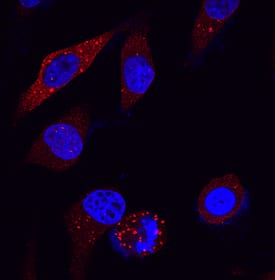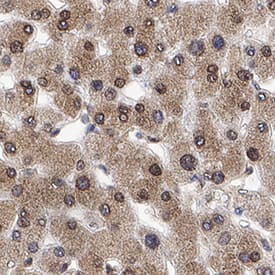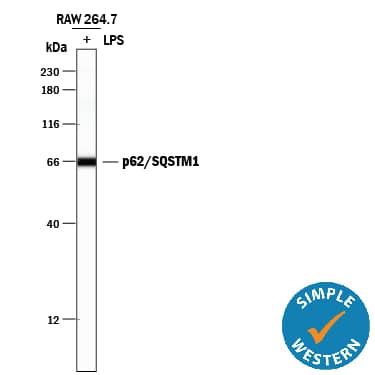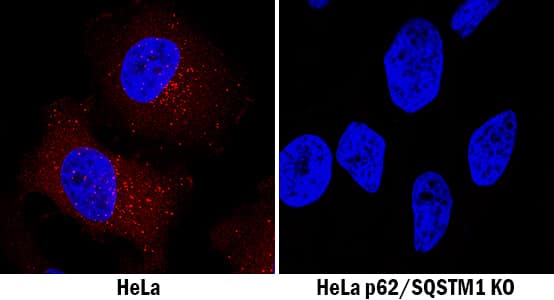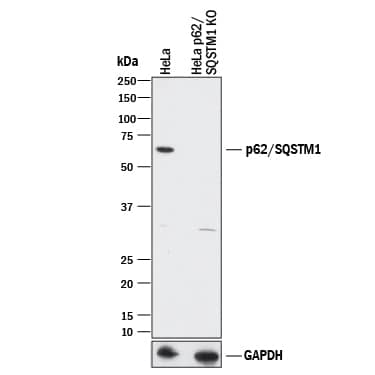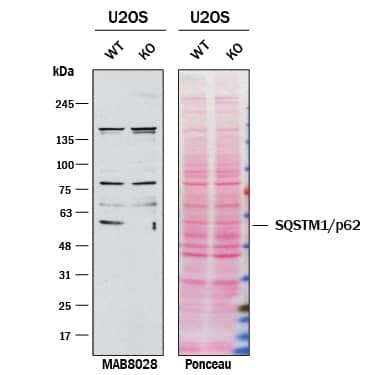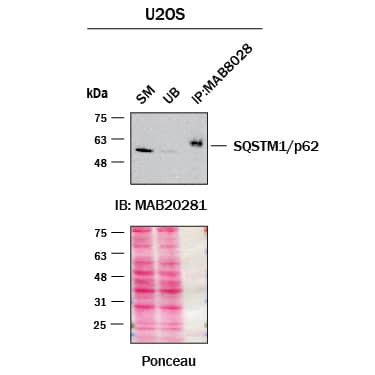Human/Mouse/Rat p62/SQSTM1 Antibody
R&D Systems, part of Bio-Techne | Catalog # MAB8028


Conjugate
Catalog #
Key Product Details
Validated by
Knockout/Knockdown
Species Reactivity
Validated:
Human, Mouse, Rat
Cited:
Human, Mouse, Rat
Applications
Validated:
Immunocytochemistry, Immunohistochemistry, Immunoprecipitation, Knockout Validated, Simple Western, Western Blot
Cited:
Immunocytochemistry, Western Blot
Label
Unconjugated
Antibody Source
Monoclonal Mouse IgG1 Clone # 864807
Product Summary for Human/Mouse/Rat p62/SQSTM1 Antibody
Specificity
Detects human p62/SQSTM1 in ELISAs. Detects human, mouse and rat p62/SQSTM1 in Western blots
Clonality
Monoclonal
Host
Mouse
Isotype
IgG1
Scientific Data Images for Human/Mouse/Rat p62/SQSTM1 Antibody
Detection of Human, Mouse, and Rat p62/SQSTM1 by Western Blot.
Western blot shows lysates of HeLa human cervical epithelial carcinoma cell line, RAW 264.7 mouse monocyte/macrophage cell line, and C6 rat glioma cell line untreated (-) or treated (+) with 1 µg/mL LPS for 24 hours. PVDF membrane was probed with 2 µg/mL of Mouse Anti-Human/Mouse/Rat p62/SQSTM1 Monoclonal Antibody (Catalog # MAB8028) followed by HRP-conjugated Anti-Mouse IgG Secondary Antibody (HAF018). A specific band was detected for p62/SQSTM1 at approximately 62 kDa (as indicated). This experiment was conducted under reducing conditions and using Immunoblot Buffer Group 1.p62/SQSTM1 in HeLa Human Cell Line.
p62/SQSTM1 was detected in immersion fixed HeLa human cervical epithelial carcinoma cell line using Mouse Anti-Human/Mouse/Rat p62/SQSTM1 Monoclonal Antibody (Catalog # MAB8028) at 25 µg/mL for 3 hours at room temperature. Cells were stained using the NorthernLights™ 557-conjugated Anti-Mouse IgG Secondary Antibody (red; NL007) and counterstained with DAPI (blue). Specific staining was localized to phagosomes in cell cytoplasm. View our protocol for Fluorescent ICC Staining of Cells on Coverslips.p62/SQSTM1 in Human Liver.
p62/SQSTM1 was detected in immersion fixed paraffin-embedded sections of human liver using Mouse Anti-Human/Mouse/Rat p62/SQSTM1 Monoclonal Antibody (Catalog # MAB8028) at 5 µg/mL for 1 hour at room temperature followed by incubation with the Anti-Mouse IgG VisUCyte™ HRP Polymer Antibody (VC001). Before incubation with the primary antibody, tissue was subjected to heat-induced epitope retrieval using Antigen Retrieval Reagent-Basic (CTS013). Tissue was stained using DAB (brown) and counterstained with hematoxylin (blue). Specific staining was localized to nuclei and cytoplasm in hepatocytes. Staining was performed using our protocol for IHC Staining with VisUCyte HRP Polymer Detection Reagents.Applications for Human/Mouse/Rat p62/SQSTM1 Antibody
Application
Recommended Usage
Immunocytochemistry
8-25 µg/mL
Sample: Immersion fixed HeLa human cervical epithelial carcinoma cell line
Sample: Immersion fixed HeLa human cervical epithelial carcinoma cell line
Immunohistochemistry
5-25 µg/mL
Sample: Immersion fixed paraffin-embedded sections of human liver
Sample: Immersion fixed paraffin-embedded sections of human liver
Immunoprecipitation
1 µg/1 mg cell lysate
Sample: Cell lysate of U2OS human osteosarcoma cell line
Sample: Cell lysate of U2OS human osteosarcoma cell line
Knockout Validated
p62/SQSTM1 is specifically detected in HeLa human cervical epithelial carcinoma parental cell line and parental U2OS cell line but is not detectable in p62/SQSTM1 knockout HeLa cell line and knockout U2OS cell line.
Simple Western
20 µg/mL
Sample: RAW 264.7 mouse monocyte/macrophage cell line treated with LPS
Sample: RAW 264.7 mouse monocyte/macrophage cell line treated with LPS
Western Blot
2 µg/mL
Sample: HeLa human cervical epithelial carcinoma cell line, RAW 264.7 mouse monocyte/macrophage cell line, and C6 rat glioma cell line untreated or treated with LPS
Sample: HeLa human cervical epithelial carcinoma cell line, RAW 264.7 mouse monocyte/macrophage cell line, and C6 rat glioma cell line untreated or treated with LPS
Please Note: Optimal dilutions of this antibody should be experimentally determined.
Reviewed Applications
Read 2 reviews rated 5 using MAB8028 in the following applications:
Formulation, Preparation, and Storage
Reconstitution
Sterile PBS to a final concentration of 0.5 mg/mL. For liquid material, refer to CoA for concentration.
Formulation
Lyophilized from a 0.2 μm filtered solution in PBS with Trehalose. See Certificate of Analysis for details.
*Small pack size (-SP) is supplied either lyophilized or as a 0.2 µm filtered solution in PBS.
*Small pack size (-SP) is supplied either lyophilized or as a 0.2 µm filtered solution in PBS.
Stability & Storage
Store the unopened product at -20 to -70 °C. Use a manual defrost freezer and avoid repeated freeze-thaw cycles. Do not use past expiration date.
Background: p62/SQSTM1
Long Name
Sequestosome 1
Alternate Names
A170, EBIAP, ORCA, OSIL, PDB3, Sequestosome 1, SQSTM1, ZIP3
Gene Symbol
SQSTM1
UniProt
Additional p62/SQSTM1 Products
Product Documents for Human/Mouse/Rat p62/SQSTM1 Antibody
Product Specific Notices for Human/Mouse/Rat p62/SQSTM1 Antibody
For research use only
